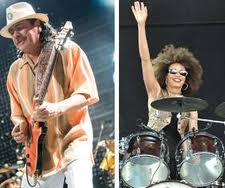Spectrum Road — electric guitarist Vernon Reid, bassist Jack Bruce, keyboardist John Medeski and drummer Cindy Blackman — playing high energy, high volume music at the Blue Note (NYC) this weekend inspired by the jazz-rock amalgam the late, great Tony Williams created 40 years ago, seems utterly cutting edge. Or is it just my old ears, getting deaf to quieter subtleties?
Big fun news: Santana weds Blackman, Herbie & Wayne play
The rare notable jazz wedding to celebrate: Beyond-jazz, rock & Latin guitarist Carlos Santana to drummer Cindy Blackman, who’s had a

Artists’ promotional photos
great recording year, issuing Another Lifetime, her smashing tribute to the late Tony Williams) and driving Organ Monk, Greg Lewis’s trio album that made my top 10.
Santana’s best albums after the first one always have had a outward reach — Abraxis, Caravanserai, his spiritualized rave up Love, Devotion and Surrender with John McLaughlin and organist Larry (Khalid Yasin) Young, and 1990’s Swing of Delight, featuring ex-Miles men Herbie Hancock and Wayne Shorter (who made music at the wedding), Ron Carter and, yes, Tony Williams. Carlos and Cindy — play hard and prosper!
howardmandel.com
Subscribe by Email |
Subscribe by RSS |
Follow on Twitter
All JBJ posts |
Miles’ beyond jazz, today and tomorrow
Miles Davis is still at it — in Prospect Park, the Highline Ballroom, (le) Poisson Rouge, Carefusion Jazz Festival’s Carnegie Hall concerts, also overflowing the Montreal Museum of Fine Arts, as per my City Arts – New York column and enriching the glorious Festival International de Jazz de Montreal (June 25 – July 5).
Though he died of exacerbated living at age 65 in 1991, the influence of Miles’ trumpet and his breakthrough “directions in music” vibrates through urbane international cultural as strongly now as ever. Bitches Brew, which launched a jazz-rock revolution, and Tutu, his most ambitious late-period album, are inspiring high visibility concert performances that are exciting in their own rights, unveiling a potential future rather than reviving the past.
This Miles wave isn’t nostalgia-based: it’s a wake-up call for a world short on  sharp melodies, harmonic exploration, rampant rhythm, full-force interaction. Audiences I’ve encountered seem eager to hear again or for the first time Miles’ many modes — from aching fragility to hippest cool to surrealistic phantasmagoria to imperious swagger, all conveyed with surprising, original lyricism.
